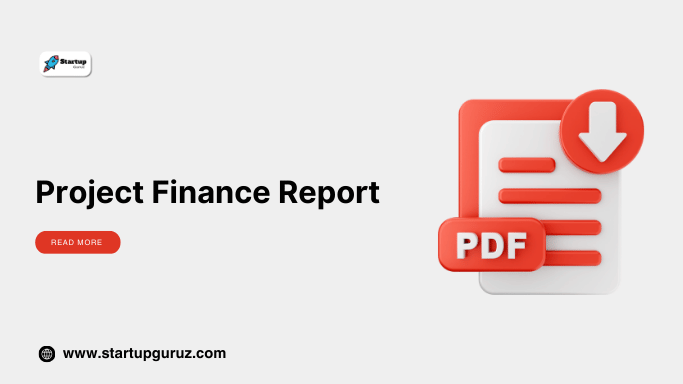Project Finance Report
Project Finance Report: A Complete Guide
Introduction to Project Finance Report
A Project Finance Report is a crucial document that provides a detailed financial analysis of a project, helping investors, lenders, and stakeholders evaluate its feasibility, risks, and profitability. This report is essential for securing funding from banks, financial institutions, or private investors.
Whether you are starting a new business, expanding operations, or developing infrastructure projects, a well-prepared project finance report increases your chances of securing funding.
This guide will cover the components, preparation process, sample report, and FAQs to help you create an effective project finance report.

What is a Project Finance Report?
A Project Finance Report (PFR) is a comprehensive document that outlines:
✔ Project objectives and scope
✔ Capital investment and funding requirements
✔ Projected revenue and expenses
✔ Financial risk assessment
✔ Loan repayment schedule
A well-structured PFR provides lenders and investors with a clear financial roadmap, ensuring transparency and trust in the project’s viability.
Importance of a Project Finance Report
✔ Essential for loan and investment approval
✔ Demonstrates financial feasibility
✔ Helps in business planning and execution
✔ Assists in risk management
✔ Provides a structured financial roadmap
Key Components of a Project Finance Report
1. Cover Page & Executive Summary
- Project Title
- Prepared by
- Date of Submission
- Summary of the Report
2. Project Overview
- Business Model
- Industry & Market Analysis
- Objectives and Expected Outcomes
3. Financial Requirements & Capital Investment
- Total Project Cost
- Funding Breakdown (Equity, Loans, Grants)
- Fixed vs. Working Capital
4. Revenue Model & Financial Projections
- Estimated Revenue Streams
- Cost Structure & Expense Breakdown
- Profit & Loss Forecast
5. Risk Assessment & Mitigation Strategies
- Financial Risks
- Market & Operational Risks
- Contingency Planning
6. Loan Repayment Plan & ROI Analysis
- Interest Rate & Loan Tenure
- Expected ROI (Return on Investment)
- Payback Period Calculation
7. Compliance & Legal Considerations
- Licenses & Permits Required
- Regulatory Compliance
- Taxation & Other Legal Aspects
8. Conclusion & Recommendations
- Summary of Findings
- Final Financial Insights
- Next Steps
How to Prepare a Project Finance Report?
Step 1: Define Project Scope & Objectives
Clearly outline what the project aims to achieve and its economic impact.
Step 2: Conduct Market & Industry Research
Analyze market trends, demand, competition, and potential profitability.
Step 3: Determine Financial Needs & Funding Sources
Identify total investment, expected funding sources, and capital structure.
Step 4: Develop Financial Projections
Estimate revenue, expenses, profit margins, and break-even points.
Step 5: Analyze Risks & Plan for Mitigation
Assess financial, operational, and market risks with preventive measures.
Step 6: Structure the Report Professionally
Use clear headings, financial tables, and a logical flow.
Step 7: Review & Submit
Ensure the report is error-free, realistic, and well-documented before submission.
Sample Project Finance Report (Example)
Project Name: Green Energy Solar Park
Prepared By: ABC Energy Solutions Pvt. Ltd.
Submission Date: March 2025
Executive Summary
The project aims to set up a 5 MW solar energy plant to generate clean electricity and supply it to industries.
Market Analysis
- India’s solar energy market is growing at 25% annually.
- Government incentives available for renewable energy projects.
Financial Overview
- Total Project Cost: ₹50 Crore
- Loan Required: ₹35 Crore
- Revenue Projection: ₹12 Crore annually
Loan Repayment Plan
- Interest Rate: 8% per annum
- Loan Tenure: 10 years
- Monthly EMI: ₹42 Lakh
Risk Analysis & Mitigation
- Market Risk: Government policies impact solar power tariffs.
- Solution: Long-term Power Purchase Agreements (PPAs) to ensure stable pricing.
Conclusion
The project is financially viable with a payback period of 5 years, making it a strong candidate for funding.
Benefits of a Well-Structured Project Finance Report
✔ Increases chances of securing funding
✔ Helps in business execution & management
✔ Ensures transparency with investors & lenders
✔ Reduces financial and operational risks
Frequently Asked Questions (FAQs)
1. What is a project finance report?
A Project Finance Report is a document outlining financial aspects, funding needs, and risk analysis for a proposed project.
2. Why is a project finance report necessary?
It is essential for securing bank loans, attracting investors, and ensuring financial feasibility of a project.
3. What are the key components of a finance report?
It includes financial projections, capital investment details, revenue models, risk analysis, and loan repayment plans.
4. How do I calculate the financial viability of a project?
Use ROI analysis, payback period, and Net Present Value (NPV) calculations to assess viability.
5. Can startups prepare project finance reports?
Yes, startups must present a strong business model and financial strategy in their reports to secure funding.
6. How do banks evaluate project finance reports?
Banks check loan repayment capacity, revenue projections, market analysis, and risk mitigation strategies.
7. What software is used for financial analysis in reports?
Popular tools include Excel, QuickBooks, Tally, and financial modeling software like FinModelsLab.
8. Can I get a sample project finance report for free?
Yes, many banks, government portals, and financial consultants provide sample reports for reference.
9. What should I avoid in a project finance report?
Avoid unrealistic projections, missing risk analysis, and lack of clear funding details.
10. How often should I update my project finance report?
It should be updated annually or whenever there are significant financial changes.